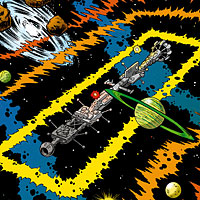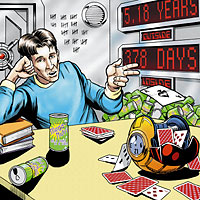Time Travel Research Center © 2005 Cetin BAL - GSM:+90 05366063183 - Turkey/Denizli
A User's Guide to Time Travel
All it takes is a grasp of theoretical physics, control of the space-time continuum, and maybe a ball of cosmic string.
By Michio Kaku
Did the tech bubble burst in your face? Were you one of those unlucky outsiders who missed the Yahoo! IPO or got stuck with Enron stock long after the execs had dumped theirs? Wouldn't you like to be, just once, in the right place at the right time? Now you can. Follow a few simple instructions to relive the bull market and bail out just in time - then go on to march with Pericles or meet your great-great-great-grandchild.
Once confined to fantasy and science fiction, time travel is now simply an engineering problem. Physicists schooled in Newton's laws believed that time moved along a straight, steady course, like a speeding arrow. Then came Einstein in the early 1900s. His equations showed that time is more like a river. The more mass or energy you possess, the more the current around you varies. By moving at high velocity, for instance, you can make time slow down, and when you come to a stop, you'll be younger than if you'd remained at rest. Thus, a speedy spacecraft makes a fairly basic time machine.
Even after Einstein, most physicists believed the clock ticked in only one direction. While moving faster than the speed of light could, according to Einstein's equations, reverse time's arrow, such motion was impossible, because any object that reached that velocity would become infinite in mass. Trips to the past were preposterous.
Not anymore. Having examined Einstein's equations more closely, physicists now realize that the river of time may be diverted into a whirlpool - called a closed timelike curve - or even a fork leading to a parallel universe. In particular, the more mass you can concentrate at a single point, the more you can bend the flow.
In recent years, new designs for time machines have been flying off drawing boards at the world's top science labs. Exact specifications depend on where in time and space you wish to travel. You'll need a hefty CPU to solve the relevant equations for your machine's precise size, shape, motion, location, surroundings, and so on; the more accurately you can nail down these variables, the closer you'll come to your intended destination.
The designs that follow don't have the panache of Doc Brown's DeLorean in Back to the Future or even H. G. Wells' brass and quartz dream machine, but they do put time travel within reach of anyone with a couple of fast spaceships, a supercomputer, and a solar-system-scale machine shop. Warning: Time-space distortions may not be stable and may collapse as you enter, so approach them at your own risk. Also, when going back in time, do not - repeat - do not kill your parents before you are born. Wired takes no responsibility for parallel universes in which you find yourself trapped for eternity.
Throne Plates
 Miracle Studios |
When Carl Sagan was writing his 1985 novel Contact, he asked Caltech physicist Kip Thorne how to abbreviate the lengthy flight time required for a trip to a distant star. Thorne suggested a wormhole, a shortcut through space-time that almost certainly exists as a consequence of Einsteinian principles, although one has yet to be detected. A few years later, Thorne suggested that a wormhole's entrances could be positioned in space and time as desired. Unlike some other time machines, this Thorne-inspired design allows round trips. However, it can't take you back to a time before the machine was built. Here's how it works:
Obtain four large conductive plates at least a few miles in diameter.
Arrange them in parallel, very close together. The space between each plate
will teem with negative energy - a proven phenomenon known as the Casimir
effect - creating slices of identical space-time.
Separate the plates into two pairs. A wormhole will connect the pairs like
an umbilical cord.
Place one pair in a rocket ship and accelerate to almost the speed of light,
preferably in a circular path so the rocket doesn't stray too far. Time will
nearly freeze for that set while the other, still on the ground, ages at the
usual rate. With each passing moment, the space-borne plates will go farther
back in time relative to the others.
When a sufficient amount of time has passed - preferably decades - step
between the earthbound plates. You'll immediately be transported back in
time and across space to the other pair.
Fine print: To activate Thorne plates, the distance between each plate must be less than the width of an atom. The resulting wormhole will be equally small, so getting in and out might be difficult. To widen the portal, some scientists suggest using a laser to inject immense amounts of negative energy. In addition, Thorne believes that radiation effects created by gravitons, or particles of gravity, might fry you as you enter the wormhole. According to string theory, however, this probably won't happen, so it's scant reason to cancel your trip.
Gott Loop
 Miracle Studios |
Many scientists believe the big bang that created the universe left behind cosmic strings - thin, infinitely long filaments of compressed matter. In 1991, Princeton physicist J. Richard Gott discovered that two of these structures, arranged in parallel and moving in opposite directions, would warp space-time to allow travel to the past. He later reworked the idea to involve a single cosmic-string loop. A Gott loop can take you back in time but not forward. The guide to building your own:
Scan the galaxy for a loop of cosmic string.
When you find one, fly close to it in a massive spaceship. Use the ship's
gravity to shape the string into a rectangle roughly 54,000 light-years long
and .01 light-years wide. Gravity exerted by the longer sides of the
rectangle will cause it to collapse, bringing the sides closer and closer
together at nearly the speed of light.
As the two sides approach within 10 feet of each other, circle them in a
smaller ship. When you return to the start of the circle, you will have
traveled back in time.
Fine print: To take you back one year, the string must weigh about half as much as the Milky Way galaxy. You'll need a mighty big spaceship to make that rectangle.
Gott Shell
 Miracle Studios |
In essence, a Gott shell is a huge concentration of mass. The shell's sheer density creates a gravitational field that slows down the clock for anyone enclosed within it. Outside, time rolls along at its familiar pace, but inside, it creeps. Thus the Gott shell is useful for travel into the future only. If you're planning a jaunt to the past using a Gott loop, you might want to bring along a Gott shell for the return trip. What to do, step by step:
Salvage scrap planetary matter to assemble a mass equal to or greater than
Jupiter's.
Working slowly so as not to produce sudden gravitational disturbances,
assemble the matter around yourself in a sphere. For your comfort - and to
avoid inadvertently creating a black hole later in the process - be sure to
leave a cavity larger than 18 feet in diameter at the center.
Stock the cockpit with lots of food, drink, diversions, and back issues of
Wired. Your journey might take a while.
Using a high-powered energy source, compress the shell. The greater the
compression, the faster you'll be transported - up to five times the pace of
ordinary time for a Jupiter-sized mass, faster for a larger ball of matter.
After waiting the desired interval - several decades works best - slowly
decompress the shell and emerge. You'll find yourself in the same place but
in a distant epoch. Welcome to the future.
Fine print: This is a relatively slow method of time travel, and life inside the shell could become tedious.
Van Stokum Cylinder
 Miracle Studios |
Mass and energy act on space-time like a rock thrown into a pond: the bigger the rock, the bigger the ripples. Physicist W. J. van Stockum realized in 1937 that an immense cylinder spinning at near-light speed will stir space-time as though it were molasses, pulling it along as the cylinder turns. Although Van Stockum himself didn't recognize it, anyone orbiting such a cylinder in the direction of the spin will be caught in the current and, from the perspective of a distant observer, exceed the speed of light. The result: Time flows backward. Circle the cylinder in the other direction with just the right trajectory, and this machine can take you into the future as well. How it works:
Using a high-performance spacecraft with tractor beams, or at least heavy-duty
cables, trawl the galaxy gathering planets, asteroids, comets, and the like.
Collect as much matter as you can.
With a galactic-scale forge, extrude the planetary matter into a long,
dense cylinder.
Use an industrial-strength electromagnetic field to spin the cylinder along
its central axis. Accelerate it to the speed corresponding to your
destination time.
Orbit the cylinder in the direction of the spin. With each circuit you make,
you'll return at a time before you left.
Fine print: The cylinder must be infinitely long, which could add slightly to its cost.
Kerr Ring
 Miracle Studios |
When Karl Schwarzschild solved Einstein's equations in 1917, he found that stars can collapse into infinitesimally small points in space - what we now call black holes. Four decades later, physicist Roy Kerr discovered that some stars are saved from total collapse and become rotating rings. Kerr didn't regard these rings as time machines. However, because their intense gravity distorts space-time, and because they permit large objects to enter on one side and exit on the other in one piece, Kerr-type black holes can serve as portals to the past or the future. If finding one with the proper dimensions is too much trouble, you can always build one yourself:
Gather enough matter to equal Jupiter's mass.
Compress it into a ring about 5 feet in diameter. This can put a lot of
stress on mechanical tools, so a high-energy electromagnetic field is
recommended.
As you compress the ring, set it spinning. Increase its velocity to nearly
the speed of light. A black hole will form at its center.
Step through the hole and you'll be transported instantly to another time (and,
possibly, place), potentially as far back as the big bang or as far forward
as the end of the universe as we know it. Bon voyage!
Fine print: The Kerr ring is a one-way ticket. The black hole's gravity is so great that, once you step through it, you won't be able to return.
Michio Kaku (www.mkaku.org) is a professor of theoretical physics at City University of New York. His latest book is Hyperspace.
Copyright © 1993-2004 The Condé Nast Publications Inc. All rights reserved.
Copyright © 1994-2003 Wired Digital, Inc. All rights reserved.
Hiçbir yazı/ resim izinsiz olarak kullanılamaz!! Telif hakları uyarınca bu bir suçtur..! Tüm hakları Çetin BAL' a aittir. Kaynak gösterilmek şartıyla siteden alıntı yapılabilir.
The Time Machine Project © 2005 Cetin BAL - GSM:+90 05366063183 -Turkiye/Denizli
Ana Sayfa /
index /Roket bilimi /![]() E-Mail /CetinBAL/Quantum Teleportation-2
E-Mail /CetinBAL/Quantum Teleportation-2
Time Travel Technology /Ziyaretçi Defteri /UFO Technology/Duyuru